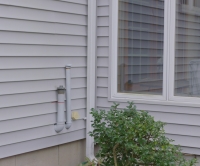Residential Home Heating Oil Tank Maintenance
Note: Underground storage tanks serving five or more residential units are regulated under RCSA 22a-449(d)-1.

What You Can Do
- Make sure the fill pipe is easily accessible to delivery people.
- Keep the vent line clear of snow, ice, insect nests, or anything else that might block airflow.
- Monitor your heating oil use and compare it to past heating seasons.
- Discuss delivery procedures and spill protocols with your heating oil supplier.
- Use DEEP's Yearly Tanks Safety Checklist to identify problems that could lead to a leak from your aboveground storage tank.

Why Tank Maintenance is Important
Leaks from home heating oil tanks can:
- pollute drinking water wells,
- cause odor and potentially vapor problems inside the house,
- pollute sumps, sewers, septic systems, wetlands, and streams,
- cost a lot of money to clean up, and
- reduce home values.

Signs of a leak can include:
- unexplained increase in fuel usage,
- signs of oil or withered or dead grass or plants near tank, fill or vent pipes,
- visible stains or wet spots on tank surface or under the tank,
- heating oil odor near tank (make sure cap is on securely),
- water in tank, and/or
- oil staining on concrete floors or walls between the tank and boiler or furnace (typically found above a buried heating oil pipe that is leaking).
The following LUSTLine articles contain valuable information on residential heating oil tanks:
- Tanks Down East –Those Tanks in America’s Backyards and Basements
- Tanks Down East – A Report from Maine on the Trials and Tribulations of Leaking Aboveground Home Heating Oil Tanks
Video: Prevent Home Heating Oil Leaks and Spills
Hear a Connecticut homeowner’s story about their experience having an unprotected oil line running from an oil tank to a furnace under their basement floor.
Considerations for Replacement
 The best way to avoid cleanup costs is to replace the tank and/or piping before it leaks. Like all equipment, tanks and piping have limited useful life expectancies. Life expectancies will depend on tank or piping construction and their environmental conditions. Situations where replacement should occur:
The best way to avoid cleanup costs is to replace the tank and/or piping before it leaks. Like all equipment, tanks and piping have limited useful life expectancies. Life expectancies will depend on tank or piping construction and their environmental conditions. Situations where replacement should occur:- If any sign of a leak exists, empty the tank immediately and remove the tank and/or piping.
- If you have a 275 gallon underground storage tank, it should be removed as soon as possible. Those tanks are designed for aboveground use, so are much more likely to leak if installed underground.
 If unprotected piping is located under a concrete floor, it should be replaced with piping that runs along the wall or overhead where it can be seen. If piping must be installed under the floor, install coated flexible copper pipe or run the piping through a protective sleeve (Maine DEP).
If unprotected piping is located under a concrete floor, it should be replaced with piping that runs along the wall or overhead where it can be seen. If piping must be installed under the floor, install coated flexible copper pipe or run the piping through a protective sleeve (Maine DEP).
-
If your tank is beyond its life expectancy.
- Underground tanks – unprotected steel about 15 years
- Underground tanks – fiberglass, cathodically-protected steel, or composite (steel-clad) –beyond their 30 year warranties
- Outside aboveground tanks – about 25 years, depending on conditions
- Aboveground tanks in a protected, dry location will frequently last longer than outside tanks. Check for signs of a leak annually, such as before filling the tank each summer.
Recordkeeping for Home Sales
Homebuyers and banks frequently want assurances that underground tanks did not leak or that any leak had been cleaned up prior to closing. When you remove an underground tank, hire a registered contractor. Collect soil samples and analyze for Extractable Total Petroleum Hydrocarbons (ETPH) at a Connecticut certified laboratory. Contractors frequently collect samples and deliver them to a certified lab for you. Take photos of the tank and the excavation, if possible. A contractor’s letter report (approximately 1 page) documenting the tank removal is also good to have. Keep these documents in a safe place.
Residential Home Heating Oil Tanks
Content Last updated October 2021

